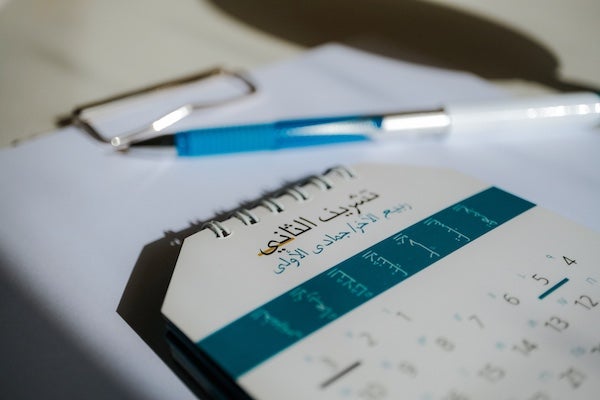
The Arabic month is closely tied to the lunar or crescent cycle to the point that the word "month" in Arabic signifies the moon or crescent. It is called a "shahr" because it becomes "Mashhur," which means ‘known’, referring to the Moon’s appearance at the beginning and end of each month. The Islamic acts of worship are closely linked to this system. The prophet, peace be upon him, said: "Observe fast on sighting it (the new moon) and break (fast) on sighting it (the new moon), …" (Hadith, Sahih Muslim).
The Islamic calendar is primarily based on the lunar calendar, which aligns with other calendars in terms of the number of months yet differs in the number of days due to reliance on the lunar cycle. The Arabic months consist of 12 months, a fact affirmed by Islam. Allah, Subhanahu Wa Ta'ala, says:
"Indeed, the number of months ordained by Allah is twelve—in Allah’s Record since the day He created the heavens and the earth—of which four are sacred. That is the Right Way. So do not wrong one another during these months, ..." (At-Tawbah: 36).
Allah decreed this number on the day He created the heavens and the earth, and His ruling remains firm despite the pre-Islamic Arabs tampering with the calendar. They sometimes made the months thirteen or changed their order to suit their interests, such as hastening war or even performing Hajj outside the month of Dhu al-Hijjah.
This is why the Prophet, peace be upon him, declared in his Farewell Pilgrimage speech:
"The division of time has turned to its original form which was current when Allah created the Heavens and the Earths. The year is of twelve months, out of which four months are sacred: Three are in succession: Dhul-Qa'da, Dhul-Hijja, and Muharram, and (the fourth is) Rajab of (the tribe of) Mudar, which comes between Jumadi-ath-Thaniyah and Sha ban" (Hadith, Sahih al-Bukhari).
In other words, the months had reverted to their proper sequence, coinciding with the Farewell Pilgrimage, thereby nullifying the manipulations of pre-Islamic Arabs.
The Naming of the Arabic Months
Originally, the Arabs used various names for the months, but they eventually settled on the ones we use today. The names of the months were derived based on climatic conditions, religious customs, or circumstances prevailing at the time of naming. However, due to the lunar cycle, the names remained fixed even if the circumstances changed. As a result, the meaning of a month’s name may not always align with the season it falls in today.
Below is an explanation of the meanings of the Arabic months in order of their appearance in the Islamic calendar:
- Muharram: Also called "Shahr Allah,” which translates as ‘the Month of Allah.’ Haram means forbidden and is derived from haruma, which means prohibited. It was named so because many Arabs forbade fighting in this month, except for some tribes. Its name was particularly emphasized because the pre-Islamic Arabs would sometimes violate its sanctity, allowing warfare in one year and prohibiting the next. They even manipulated the calendar by naming Muharram Safar, which follows it and is not among the sacred months, so that they could fight and declare Safar as sacred instead. The definite article (al-) was added to its name initially as an adjective but later became part of the proper noun.
- Safar: Meaning emptiness or void, Safarwas named so because the Arabs would leave their homes empty while traveling for trade or raids after Muharram. Sometimes, Safar and Muharram were collectively called as-Safaran, meaning the two empty months.
- Rabi’ al-Awwal: Rabi’ refers to spring, a time when plants and flowers bloom. The name was given because it coincided with spring when it was first named, and the Arabs would take their livestock to graze. The term "Shahr Rabi’" which means ‘Month of Rabi’ is used to distinguish it from the spring season itself. This month is particularly honored as the birth month of the "illuminating lamp," the mercy to the world, our Prophet Muhammad, peace be upon him.
- Rabi’ al-Akhir (or Rabi’ ath-Thani): Why do we have Awwal (First) and Akhir (Last)? Perhaps because at the time of naming, the first coincided with rainfall and blooming, while the second aligned with fruit-bearing. Should Rabi’ be written with tanween (Rabi’un) as a descriptive word or as Rabi’i in a possessive form? The original form is descriptive, but possession is also grammatically acceptable.
- Jumada al-Ula: Jumud means solidification, and Jumada is a form that follows the pattern Fu’ala. This month was named because it occurred during winter when water would freeze. The name Jumada is a fixed feminine noun and does not change form. If it appears in masculine form in poetry, it is meant to refer to the month itself.
- Jumada al-Akhirah (or Jumada ath-Thaniyah): Akhirah means last, while Ukhra(also meaning last) has a different grammatical nuance, making Akhirah the correct term here. When referring to both months together, they are called Jumadan or Shahra Jumada.
- Rajab: Rajaba means revere and honor. It is one of the sacred months, and the Arabs honored it by abstaining from warfare. The Prophet, peace be upon him, specified it as Rajab of Mudar because the Mudar tribe was particularly strict in preserving its sanctity.
- Sha’ban: Derived from sha’aba, meaning to separate or disperse. It is among the words that carry opposite meanings (gathering and dispersing). The Arabs named it so because they would disperse in search of water or for military expeditions. Another view holds that it was named because it falls between the sacred months of Rajab and Ramadan. Rajab and Sha’ban together can be referred to as Rajaban.
- Ramadan: Ramid refers to intense heat, and ramda means scorching ground. It was named because it coincided with extreme heat at the time of naming. Another interpretation relates to the fasting person experiencing internal heat from thirst. Ramadan follows the pattern Fa’lan to indicate intensity. It is noteworthy that the Arabs would precede Ramadan with Shahr (Month). It is grammatically non-inflected, as mentioned in the Qur’an: "Ramaḍân is the month in which the Quran was revealed as a guide for humanity with clear proofs of guidance and the decisive authority, ..." (Al-Baqarah: 185).
- Shawwal: The first of the pilgrimage months. It was named after the phenomenon of "tashweel," which refers to a decrease in camel milk due to the intense heat.
- Dhu al-Qa’dah: One of the sacred months, named because the Arabs would refrain (qa’ada) from war and travel during it. Another theory is that they would prepare young camels (qa’dan) for riding. The plural is Dhawat al-Qa’dah.
- Dhu al-Hijjah: The month of pilgrimage, hence its name. It is the fourth of the sacred months, and its plural form is Dhawat al-Hijjah.
Religious and Ethical Significance
Beyond the linguistic analysis, the Qur’anic verse (At-Tawbah: 36) offers a profound ethical lesson. While the sacred months emphasize avoiding injustice, the verse states that this principle must be applied all year. In Islam, time and obedience are intertwined; failing to recognize the value of time leads to neglecting worship and self-oppression. Thus, understanding time’s significance is not only an individual matter but is also crucial in strengthening cultural and civilizational identity.
Thus, adopting the Hijri calendar and raising awareness about it are essential aspects of appreciating time’s value and reinforcing our connection to the Islamic heritage. This awareness should be instilled in future generations through thoughtful planning in our academic and cultural lives.
Dr. Hanan A. Alqudah, is a general Arabic language instructor at Hamad Bin Khalifa University’s (HBKU) College of Islamic Studies (CIS).
This piece has been submitted by HBKU’s Communications Directorate on behalf of its author. The thoughts and views expressed are the author’s own and do not necessarily reflect an official University stance.










